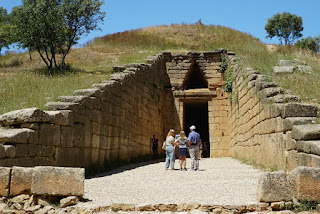May 21-22, 2025
May 21-22, 2025
Before going to bed last night, I popped back up to the roof bar to take a photo of the Acropolis lit up at night.
We strolled back through downtown, almost getting locked in the Kleinmarkthalle at closing. I got ice cream for the walk. It was much less expensive than in Greece. I am not surprised. We found Greece to be surprisingly pricey. Until very recently Greece was bargain travel. Most of the historical site tickets we bought were all 20 Euros, twice the price from just one year ago.
Also, Greece has taken their past membership in the Byzantine Empire too deeply, applying stifling rules to modern commerce. Normally when traveling with friends we split meals and travel costs on the spot avoiding monetary reconciliation later when we all have forgotten what we spent. Greece’s new Byzantine rules wouldn’t allow us to use multiple credit cards. Fortunately, I am an engineer who spreadsheets everything including my vacations.
Before going to bed last night, I popped back up to the roof bar to take a photo of the Acropolis lit up at night.
After breakfast on the rooftop with the Acropolis view again, we met our taxi for the long drive back to the Athens airport. After takeoff Aimee and I stretched out in the open row in front of us. Two hours later we landed in Frankfurt, Germany where we checked into our hotel a short walk away.
Since it is still early, we buy a day pass for the transit system and take the suburban train downtown. Like most cities in Germany, Frankfurt am Main was destroyed in WWII. Locals chose mostly to rebuild modern. The downtown is filled with skyscrapers. Frankfurt has 19 of the top 20 tallest in Germany, most of which are banks. Because of this Frankfurt has nicknames of Mainhattan and Bankfurt.
Despite the modernity, the city has a few medieval looking buildings including a tiny new Old Town. It is filled with tourists and eateries.
On the ride downtown, a talkative German lady gave us some recommendations. One was to try the Sachsenhausen cider; so we walked to that neighborhood across the Main River via the Iron Footbridge. We found a local restaurant and were pleasantly surprised to find White Asparagus on the menu. This is a delicacy in Germany only available in early summer. Asparagus turns white by covering it in dirt during the growing season so no photosynthesis can occur. It has a sweeter, less grassy taste. We order a salad of White Asparagus with Strawberries. We also order the Cordon Bleu with Grilled Potatoes special. The cider had little flavor so I switched back to their dark beer.
Since it is still early, we buy a day pass for the transit system and take the suburban train downtown. Like most cities in Germany, Frankfurt am Main was destroyed in WWII. Locals chose mostly to rebuild modern. The downtown is filled with skyscrapers. Frankfurt has 19 of the top 20 tallest in Germany, most of which are banks. Because of this Frankfurt has nicknames of Mainhattan and Bankfurt.
Despite the modernity, the city has a few medieval looking buildings including a tiny new Old Town. It is filled with tourists and eateries.
On the ride downtown, a talkative German lady gave us some recommendations. One was to try the Sachsenhausen cider; so we walked to that neighborhood across the Main River via the Iron Footbridge. We found a local restaurant and were pleasantly surprised to find White Asparagus on the menu. This is a delicacy in Germany only available in early summer. Asparagus turns white by covering it in dirt during the growing season so no photosynthesis can occur. It has a sweeter, less grassy taste. We order a salad of White Asparagus with Strawberries. We also order the Cordon Bleu with Grilled Potatoes special. The cider had little flavor so I switched back to their dark beer.
We strolled back through downtown, almost getting locked in the Kleinmarkthalle at closing. I got ice cream for the walk. It was much less expensive than in Greece. I am not surprised. We found Greece to be surprisingly pricey. Until very recently Greece was bargain travel. Most of the historical site tickets we bought were all 20 Euros, twice the price from just one year ago.
Also, Greece has taken their past membership in the Byzantine Empire too deeply, applying stifling rules to modern commerce. Normally when traveling with friends we split meals and travel costs on the spot avoiding monetary reconciliation later when we all have forgotten what we spent. Greece’s new Byzantine rules wouldn’t allow us to use multiple credit cards. Fortunately, I am an engineer who spreadsheets everything including my vacations.
Despite having just visited Germany last year, we were a little flummoxed trying to remember the basic German phrases. Apparently at my advanced age, I can only handle one foreign language per trip now. I just got used to Greek. It was not as difficult as you think once you get to know their alphabet. I was amused by our last driver-guide who taught us to count. I hadn't realized I already knew most of the numbers; Three Five Six Seven Eight Ten is Tria Pente Hexi Hepta Octo Deka.
The next morning, we return to the airport to catch our flights back to Tucson. It is uneventful but painfully long. We get home after 8 PM and I am struggling to keep my eyes open. This is the price we pay to travel around the world. I was happy to return to Greece again after so many years. Greece is a land of beauty and history sometimes captured in the same photo.



















































